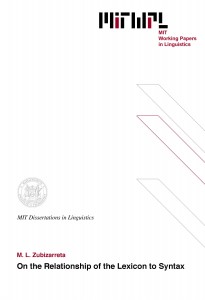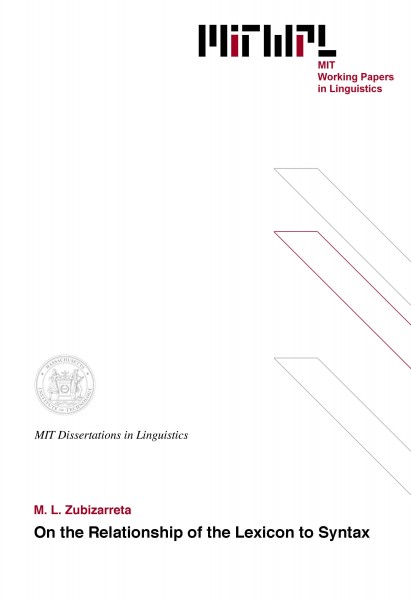On the Relationship of the Lexicon to Syntax
M. L. Zubizarreta, 1982
One of the major topics of inquiry in syntax is the relation between lexical properties and syntactic structures. This thesis is intended to be a contribution to this investigation.
In Chapters I and III, we argue that two types of predicates are to be distinguished: main-predicates and adjunct-predicates. The semantic relations induced by them may be identical in content but are formally distinct. For example, in It is obvious that Mary will pass the exam and Obviously, Mary will pass the exam the content of the relation between the adjective obvious and the S (a predicate-argument relation) and between the adverb obviously and the S (a modification relation) is the same, but they are syntactically realized in different ways. Both are defined in terms of X’-theory. Nonetheless, they differ crucially in the directionality of the categorial dependency involved. A predicate-argument relation between X and Y in some domain D is typically a relation of the form “Y is a dependent of X”, with X the head of D and Y some other category (crucially, not the head of D). On the other hand, a modification relation between X and Y in some domain D is a relation of the form “Y is a dependent of X” with X distinct from the head of D and Y some projection of the head D.
We show that th-roles assigned by adjunct-predicates are invisible for the Th-Criterion – a well-formedness condition which applies at every syntactic level and insures that every th-role is assigned to one and only one argument and every argument bears one and only one th-role. Thus, an argument may be assigned a th-role both by a main-predicate and an adjunct-predicate. For example, in John intentionally has seduced Mary both the main verb seduce and the adjunct-predicate adverb intentionally assign a th-role (an argument th-role and an adjunct th-role, respectively) to the argument in subject position. Another property of adjunct th-roles, related to the one mentioned above, is that they are assigned at LF. Thus, sentences with a subject-oriented adjunct-predicate change meaning under passive. Compare Mary intentionally has been seduced by John with its active counterpart above.
In Chapter II, we show that some types of main predicates take, either optionally or obligatorily, and adjunct subject (or more precisely, an adjunct exernal argument, as defined in Chapter I). These are raising predicates, which assign an adjunct th-role at LF to an argument selected by the verb in their clausal complement. The possibility for predicates to take adjunct external arguments derives from the fact that the subject, unlike the object, is not a subcategorized position. It is suggested that the existence of this type of predicate has implications for the typology of non-overt NPs.
While adverbs function uniquely as adjunct-predicates and adjectives function either as main- or adjunct-predicates, verbs are main-predicates “par excellence”. Nevertheless, as argues in Chapter III, there is a class of verbs, namely the modals and aspectuals, which can function in certain languages as adjunct-predicates. For example, while in French modals are main verbs, in English they are adjunct predicates (as shown by well-known syntactic texsts). This demonstrates once more that semantic relations are not solely identified by their content, but also and above all by their form.
Furthermore, we argue that there are other languages – like Spanish and Italian – in which modals and aspectuals may be analyzed simultaneously as main verbs and “syntactic affixes”. As affixes they function as adjunct-predicates: i.e., as modifiers of the verb to which they are bound. A number of peculiar properties of these verbs (the so-called “restructuring” verbs) are thus accounted for. In accord with the Projection Principle, which asserts that syntax is a projection of the lexicon, we propose that the “double-lexical properties” of modals and aspectuals in Spanish and Italian are expressed by means of parallel-syntactic analyses. Thus, sentences containing these verbs may be associated with a pair of structures – at all syntactic levels of representation.
Further motivation for parallel or simultaneous syntactic analyses is given in Chapter IV based on the Romance causative construction. It is shown that in many Romance languages, causatives, although they are argument-taking predicates, may also function as affixes, i.e., as heads of a complex-predicate. As such they may alter the argument-structure of the verb to which they are bound. Several phenomena are thus explained, in particular, the fact that causatives in these languages appear to behave as “intransitivizers”.
The analysis of modals and aspectuals in Spanish and Italian and the analysis of the Romance causatives mentioned above implies that there is no one-to-one relation between morphology and syntax. These elements are morphologically full predicates which behave as syntactic affixes. Conversely, morphological affixes – like the Japanese causative suffix sase (discussed briefly in Chapter I) – may behave syntactically as autonomous predicates.
Thesis supervisor: Noam Chomsky
Title: Institute Professor
Table of Contents
Chapter I Syntax as a projection of the lexicon 8
1 The core-semantic relations and their syntactic realization 8
2 Adjunct-semantic relations and their syntactic realization 32
Footnotes to Chapter I 47
Chapter II External-arguments: argument- and adjunct-subjects 49
1 Control and raising verbs: some differences 49
1 The distribution of expletives and idioms 49
2 The distribution of the pronoun ‘ca’ 52
3 Quantifier-scope 54
4 The distribution of the genitive clitic ‘en’ (I) 62
2 Types of non-overt NPs (I). A distinguishing feature: -th-role 66
3 VP as an adjunct th-role assigner 71
1 Mixed verbs: raising and control 71
2 Cases of obligatory adjunct th-role assignment 80
3 Summary. A classification of verbs in terms of –external
semantic role – obligatory semantic role 83
4 Non-overt NPs 86
1 Types of non-overt NPs (II). Other distinguishing features:
-pronominal, -anaphor 86
2 Co-superscripting, S’-deletion, and the i-within-I condition 94
1 An argument for the existence of [-th-role,
+anaphor, +pronominal] non-overt NPs 103
3 On the identification of non-overt NPs 107
1 Condition on the identification of pro. The
distribution of the genetive clitic ‘en’ (II) 109
Footnotes to Chapter II 117
Chapter III Verbs as adjunct-predicates 123
1 Modals as adjunct-predicates and as argument-taking predicates.
English versus French 123
2 Modals and aspectual verbs as simultaneously adjunct- and
argument-taking predicates. Spanish and Italian 135
1 The problem 135
2 The Romance SE 141
1 The reflexive se 142
2 The impersonal se 143
3 The impersonal se-passive 146
4 The ergative se and the inherent se 152
3 Auxiliary selection 155
4 A solution: simultaneous-analyses 160
1 Clitic-climbing, se-passive, and aux-selection within
a parallel-structures analysis 174
2 Quantifiers and the parallel-structures construction 181
3 Why affixes and not auxiliaries? 182
4 On the nature of parallel-structures. Speculation
and implications 184
Footnotes to Chapter III 190
Chapter IV Causatives 197
Part I The causative as an intransitivizer 197
1 The Romance causative as a bound verb 197
2 The Japanese passive 214
Part II The acc/dat causative construction 217
3 Differences between the “faire-par” and the
acc/dat causative construction 217
4 The structure of acc/dat causatives 223
5 Some remarks and speculations on case,
clitics, and order in the acc/dat causatives 244
Footnotes to Chapter IV 250

